Have you ever seen foliage in Italy? That phenomenon for which leaves, before falling, change color? Autumn is the best time to take a trip in the most evocative woods where you can enjoy the magic of foliage in Italy in 2025.
That's the best season of the year that, more than any other, embraces us in a charming and nostalgic atmosphere, the time when we gather around the fireplaces, sipping hot cup of infusion in the evening. It is the best time for those who love walking through the forests, among the vividly colored landscapes of beech, maple, and chestnut trees, but also for those who, between one path and another, love to pick the seasonal fruits, such as chestnuts, to be cooked on the grill.
In autumn nature changes and leaves turn red, golden yellow, brown and orange and then, as they fall, create a colorful carpet.
The foliage in Italy runs from the end of September to November, when landscapes and woods appear in a fairytale-like form. Here's our guide for the places along the Boot to be enchanted by this natural wonder.

Where to see foliage in Italy in 2025: a tour to discover the most beautiful places

There are countless places to visit to be amazed by the magical phenomenon of foliage in Italy. Just choose the right place for hiking, grab your binoculars and camera, and let yourself be enchanted by the landscape. Don't miss that moment at dusk, when the soft light of the sun plays with the air-dust and water vapor, further enhancing the colors of Italian forests. A sight that satisfies both soul and body, combining the aesthetic with the opportunity to reconnect with nature.
From North to South, East to West, we recommend the best places to walk with your family or go hiking on fairy-tale trails, thanks to the fantastic scenery that our peninsula can offers. We will take you on a tour, with photos and imagination, of some of the most interesting places where autumn truly lives up the atmosphere. Let's begin our journey of the foliage in Italy in 2025!
Listen to "Where to see the foliage in Italy" with Monnalisa's voice
20. The Val d'Ayas in the Aosta Valley
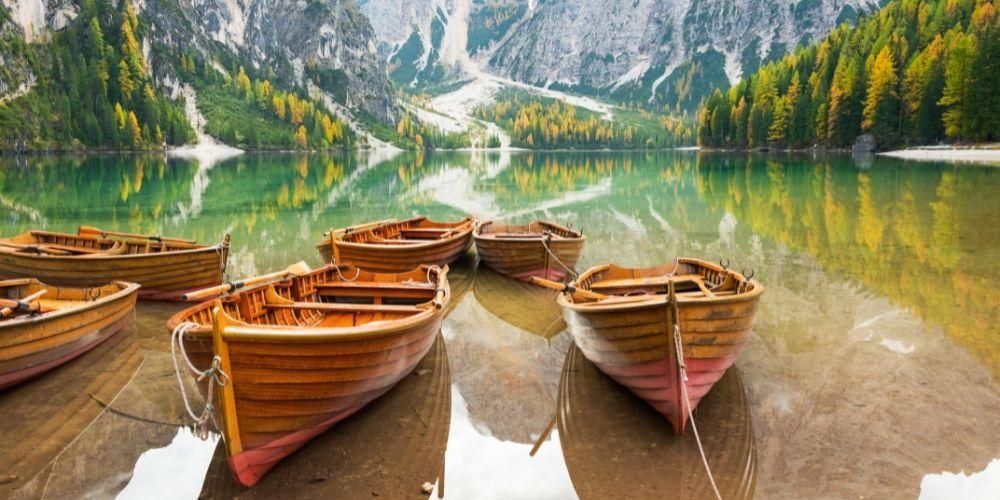
To admire the foliage in northern Italy, choose Val d'Ayas, a peaceful, stunning location at the foot of Monte Rosa, a small paradise in Val d'Aosta. The gracefulness of the breathtaking landscapes, the endless walks surrounded by nature, and the countless historical and cultural attractions highlight the surrounding area. Just take a simple walk around Lake Brusson, spectacular at this time of year, or one of the many other lakes in the area to disconnect from your usual city routine.
Here, time stands still and colors take center stage. You will just have to stop and fill your eyes with so much beauty. It will be a truly immersive experience in the most authentic nature, giving a deep sense of well-being.
Best time: late September to mid-November.
Where to park: there are several free parking lots near the Champoluc cable car (Piazzale Ramey), in Frachey near the ski lifts, in Saint-Jacques, and in Barmasc.
Services: there are numerous accommodations, cable cars, and ski lifts.
Hiking: yes, there are several hiking trails to explore the surroundings at the foot of Monte Rosa. We recommend walking along the trails of Lake Brusson, at 1300 meters, or Lake Blu, at over 1600 meters, which are among the most popular in the area. For the expert hikers, there is the Mezzalama Refuge, at over 3000 meters.
Translated with DeepL.com (free version)
19. The Langhe and the Foliage Train in Piedmont
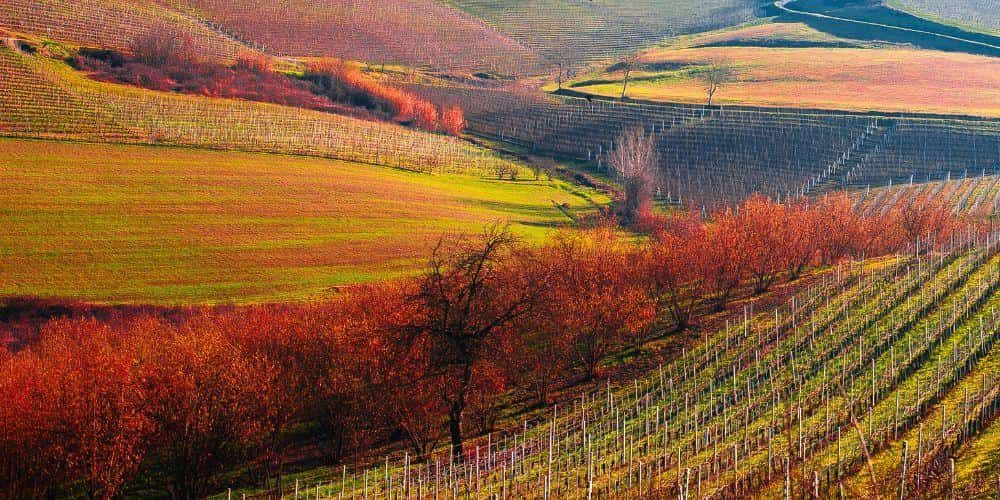
Piedmont, with its beautiful vineyard-covered hills, valleys, and mountains, is the ideal place to discover the foliage in northern Italy. The Langhe, a beautiful area between the provinces of Cuneo and Asti, in particular, features vibrant colors and the unmistakable scents of the forest. Here, temperatures drop and the intense flavors of the earth create a charming atmosphere, for those who enjoy combining excellent wine tasting with the discovery of nature.
After summer, the Langhe are enveloped in a light mist that quickly leaves way to the magical colors of autumn: red, orange, yellow, purple, and bronze become the undisputed protagonists of this season, leaving rainbow-colored hills across the region.
The Foliage Train crosses the most beautiful landscapes of this area, and if you love this amazing natural phenomenon, you can't miss the chance to take a ride, staring out the window. It leaves from Domodossola and ends in Locarno, Switzerland, but you can make several stops along the way, as well as catch the train at other stations. The route is 52 km long, about a two-hour journey, where the railway crosses the woods: a truly unique and evocative view thanks to the shades of autumn.
Best time: September-November
Where to park: To catch the Foliage Train in Domodossola, you can park in the paid parking lot in Piazza Matteotti or in the free parking lot in Via Piave, near the Vigezzina-Centovalli Railway, where the train departs.
Services: The round-trip ticket provides the option of an intermediate stop along the route, such as Santa Maria Maggiore, Re, or Swiss locations such as Intragna. Booking is mandatory. Discounts are available for museum admissions and events.
Hiking: Yes, there are countless hiking trails in the Langhe. Among the most popular are the Sentiero del Lupo (Wolf Trail) in Montelupo Albese (CN) through vineyards and hazelnut trees; the Anello di Grinzane Cavour (CN), starting from Diano d'Alba (CN), offering views of the Alps and the beautiful castle along the 10-km-walk; and the famous Sentiero del Barolo, a circular 12-km-trail through the vineyards where the wine of the same name is produced.
Find out more about Torino and Piemonte City Card18. Parks and Urban Foliage in Milan
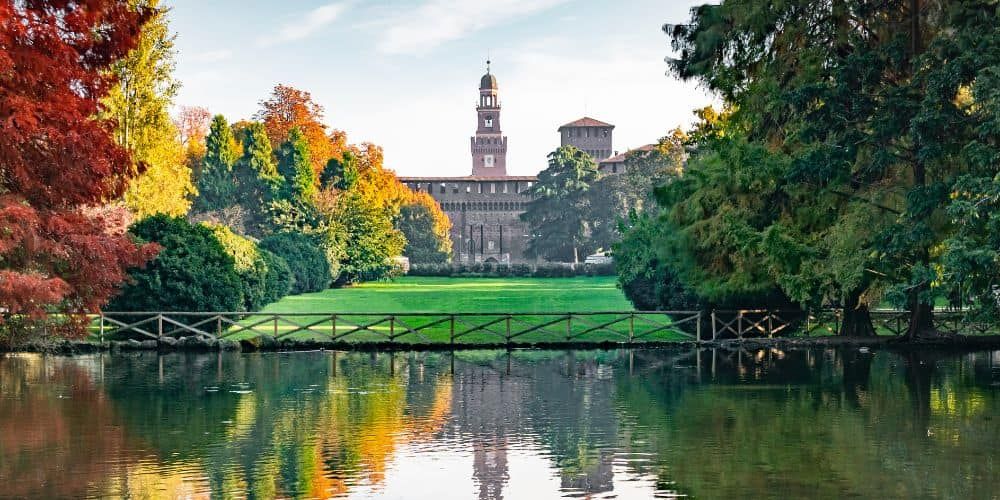
The foliage in Italy is not limited to forests: it also looks its best in urban settings, adding a hint of poetry among buildings and skyscrapers. We are in Milan, a city that always surprises, even with its so-called urban foliage. One of the most beautiful places to admire in the Lombard capital during this unique season is Parco Sempione, which is stunning in every season but offers an extra charm in autumn. You can walk, run, or relax and enjoy the sun while admiring the beautiful colors of the trees.
There are also the Indro Montanelli Public Gardens, also known as the Porta Venezia Gardens, where the atmosphere is incomparable and you won't feel like you're in the heart of a metropolis.
Don't forget Parco Lambro, located in the eastern part of the city, and the Biblioteca degli Alberi (Library of Trees), a corner of the city that recalls the Nordic countries - which is worth a visit.
Best time: October-November.
Where to park: there are numerous paid parking near Parco Sempione. If necessary, you can take a bus, tram, or the M1 (Cadorna, Cairoli) and M2 (Lanza) subway lines.
Services: at Parco Sempione, you can walk, run, visit the Castello Sforzesco, the Arco della Pace, the Civic Aquarium, and admire the Torre Branca. There are areas for picnics and sports, playgrounds for children and cafes where you can relax and have a drink.
Hiking: no.
If you're in Milan, do not miss a visit to the Duomo17. Parco di Arte Sella in Borgo Valsugana, Trentino Alto Adige
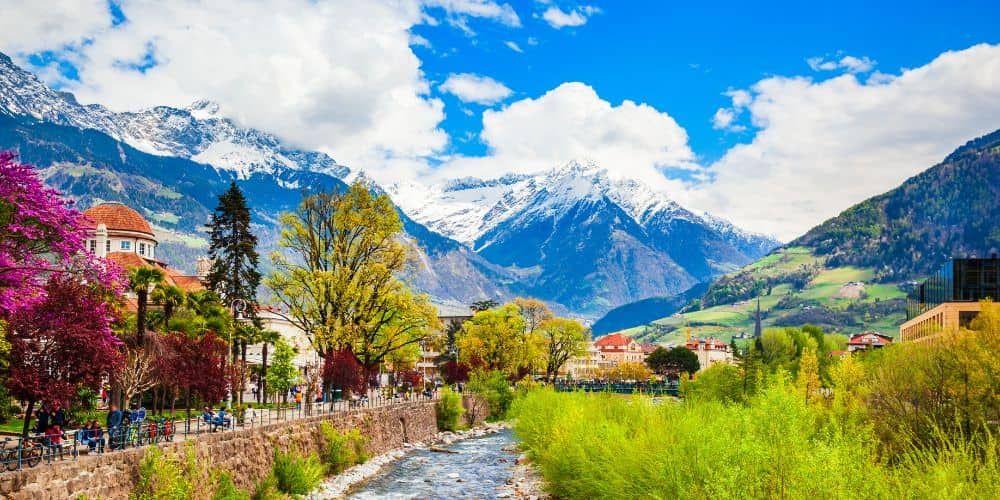
What better place than the forests of Trentino Alto Adige to observe the phenomenon of foliage in Italy? Every year, the region offers a unique and ever-changing spectacle to be enjoyed while immersed in nature. On the slopes of Monte Baldo, there is the best place to lose yourself in the lush vegetation, the Altopiano di Brentonico. The so-called “Garden of Italy” is perfect at this time of year, thanks to its rich flora. Here you can walk along paths through chestnut groves, appreciating the magnificent colors of the leaves and enjoying a hearty meal of chestnuts.
Mother Nature's masterpieces blend with those of artists in the artworks in the Parco di Arte Sella in Borgo Valsugana, an authentic open-air museum covering four hectares of woodland. The unique feature of these works is that they are mostly made of natural materials, which change with the passing of the seasons: larch wood is almost yellowish at first, but after a year it turns gray. It is an unstoppable decline, which leads to the continuous renewal of the works in the park. All around, larch, beech, and centuries-old oak trees grow up, playing with the painter's palette and reaching their maximum splendor in October.
Best time: mid-September to mid-October.
Where to park: the last useful parking lot is behind the Carlon Restaurant, from where you can reach Malga Costa, the main area of the park, in about 10 minutes on foot.
Services: the area offers a restaurant and a café.
Hiking: yes, with very short and easy trails. The ArteNatura trail is only 3.5 km long, and the Sentiero Montura trail is 4 km long, allowing you to reach the Malga Costa refuge at an altitude of 1,700 meters.
16. Val Zemola and the "glossy mountains" in Friuli Venezia Giulia
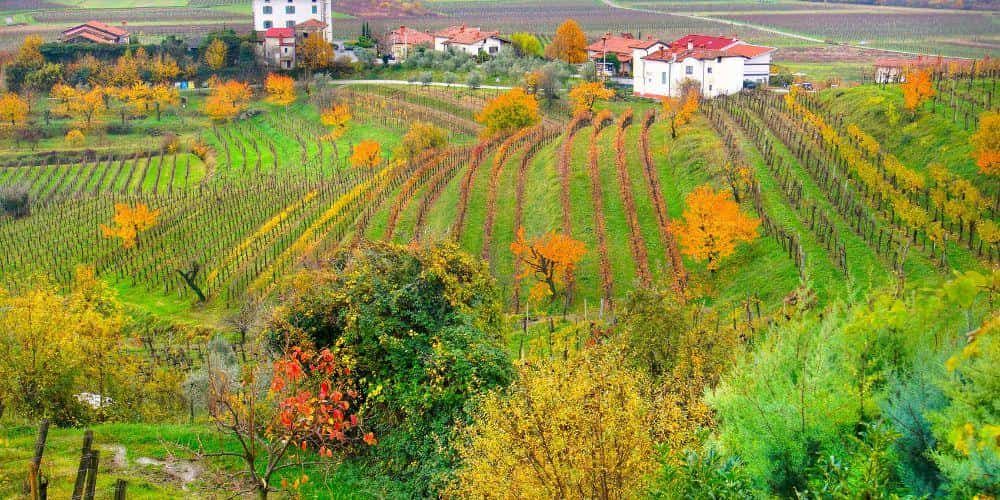
Lonely, wild and suggestive, the Zemola Valley, in Friuli Venezia Giulia, is actually a surprise, an perfect place to admire the foliage in Italy in 2025. We are very close to the "glossy mountains", which have a shiny surface due to erosion and the effect of sunlight in the Friulian Dolomites. Mauro Corona's voice, in his stories, echoes in every step as autumn paints unique sceneries.
Our walk starts from Rifugio Mela in Erto (PN), after having covered a partly dirt road, we dive into the amazing golden beech forest. Going deeper and deeper into the forest, we will cross "Le Grave", a gravel area where the stream Zemola flows. Here the landscape changes with rain, the path becomes a bit inaccessible and uphill; but it is only 400 meters of altitude away to reach the refuge Casera Galvana, close to the Duranno Mount. The effort will be rewarded because the surroundings will take your breath away: the forest is a perfect mix of larch, fir, and beech trees, each with its own color and distinct character.
Best time: September-October
Where to park: the ideal place is near the nearby towns, such as Pinzano al Tagliamento or San Daniele del Friuli, where there are several parking lots. Near the most natural areas, you can find dedicated parking lots or rest stops along the road.
Services: Casera Galvana is a shelter at 1600 meters that offers blankets, beds and a fireplace to warm up.
Hiking: Yes, to reach Casera Galvana, you can start from Rifugio Mela (at 1,200 meters) and cross “Le Grave” along the Zemola stream. It is an 11-kilometer loop trail.
15. The Valley of the Sphinxes in Veneto
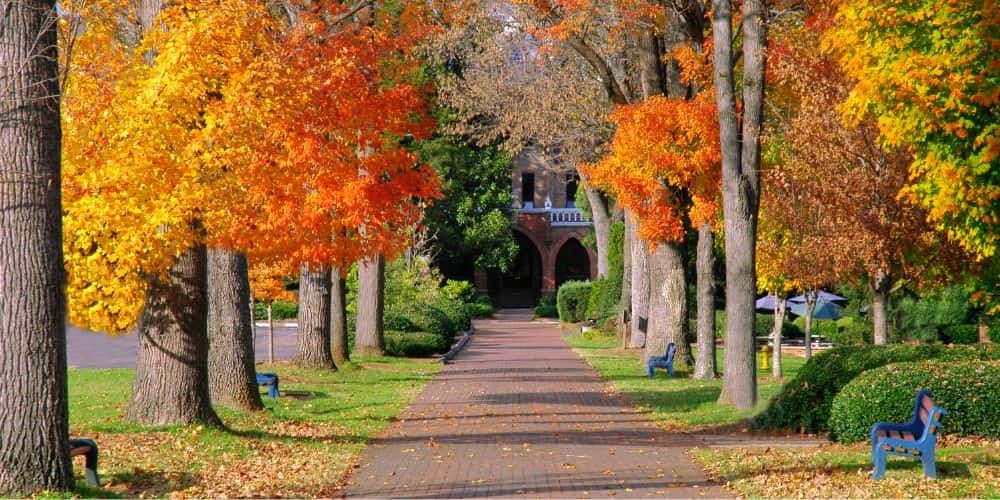
Veneto offers endless natural settings to admire the spectacle of foliage in Italy, when the woods are transformed into a colorful carpet. On the mountains in this region, you can wander around, taste chestnuts, drink good wine and enjoy local food
The place to visit is definitely the Lessinia Regional Park, in the province of Verona, where you can find incredible landforms created by karstification, such as the largest natural arch in Europe, the Ponte di Veja, and the Spluga della Preta, a chasm that plunges for about a thousand meters.
Don't miss the Valle delle Sfingi (Valley of the Sphinxes), also in the Verona area, with its fascinating limestone monoliths resembling Egyptian sphinxes, surrounded by beech forests that seem to embrace these extraordinary works shining with copper and golden hues.
Best time: September-October.
Where to park: you can park your car in the municipality of Velo Veronese, in the paid parking lot in Camposilvano.
Hiking: yes, for example, from Velo Veronese you can follow the paths of the Valley of the Sphinxes to reach the Lausen Refuge in about 9 km.
14. From the Lake Lame to the Caucaso: the Aveto Park in Liguria
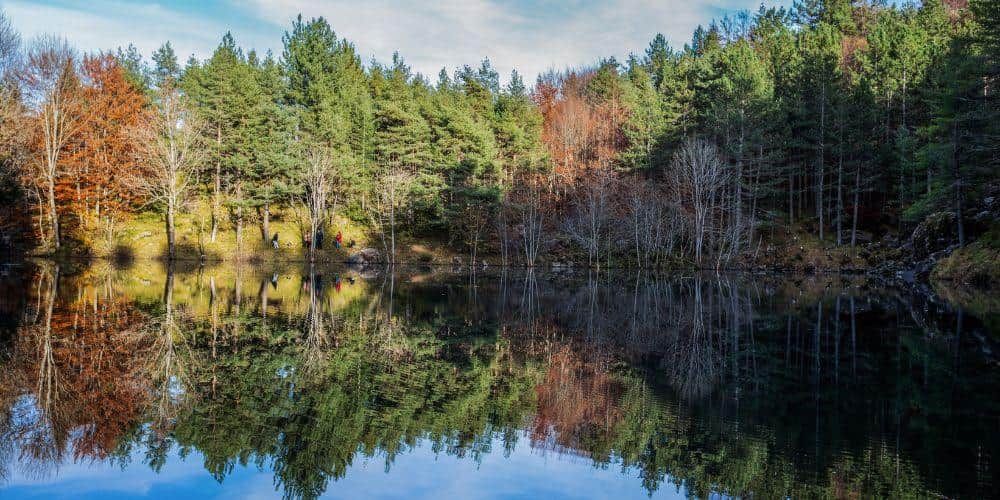
If you haven't decided where to start exploring the foliage in Italy, consider Liguria, near Genoa: the Aveto Regional Nature Park, which covers one of the most important natural areas in the entire Ligurian Apennines, offers a unique viewpoint. Established to protect a wide variety of geology, fauna, and flora, the park is rich in hazelnut and chestnut trees, as well as oaks and beeches. To fully enjoy it, the ideal route is the Anello della Scoglina, which connects three Genoese valleys: Val Fontanabuona, Val d'Aveto, and Val Trebbia.
One route starts from Passo del Bocco and leads through the beech forest of Monte Zatta to the summit, where you can enjoy a spectacular view of the Gulf of Tigullio. Alternatively, starting from Passo della Scoglina, you can reach Caucaso Mount, an area teeming with beech trees. Another picturesque itinerary for admiring this extraordinary event is the one that leads from Lame Lake to the Ravezza Fall.
Best time: October-November.
Where to park: the most convenient parking lots are located in the municipality of Santo Stefano d'Aveto.
Services: educational activities for schools and guided walks are organized. You can visit the park's library and documentation center.
Hiking: yes, the Anello della Scoglina is a circular route of about 9 km from Passo del Bocco to Mezzanego (GR) to Monte Zatta.
13. Arezzo: a medieval jem of the foliage in Tuscany
🥇 Visit Italy’s brand partnership
Parks and gardens change into authentic palettes of colors, inviting visitors to relax and enjoy the tranquility of nature. The Parco delle Rimembranze, with its large flower beds and tree-lined avenues, is the ideal place for a relaxing stroll while admiring the most evocative shades of the foliage in Italy.
From Arezzo, you can reach the Casentino Forest Park, a real paradise for lovers of unspoiled nature among oak, hornbeam, chestnut, and centuries-old beech trees. How? By taking the LFI train, which runs through the Casentino valley to Arezzo, guaranteeing an immersive and magical experience. A unique opportunity to discover the city of Arezzo and the foliage in 2025.
Best time: late October-early November.
Where to park: parking is available in Campigna, Passo della Calla, Monte Falco, or near the Hermitage of Camaldoli and the Sanctuary of La Verna.
Services: There are many different types of accommodation facilities in the municipalities within the park.
Hiking: yes. For experienced hikers, we recommend the Grande Traversata delle Foreste Sacre (Great Crossing of the Sacred Forests), a route divided into stages with varying levels of difficulty, covering a total of 45 km, which crosses the forests of the National Park from north to south. It starts from Lake Ponte di Tredozio, in Emilia Romagna, and ends at La Verna (AR).
Enjoy a wine-tasting experience of Tuscany wines12. Mount Penna: the king of the Lama Forest in Emilia Romagna
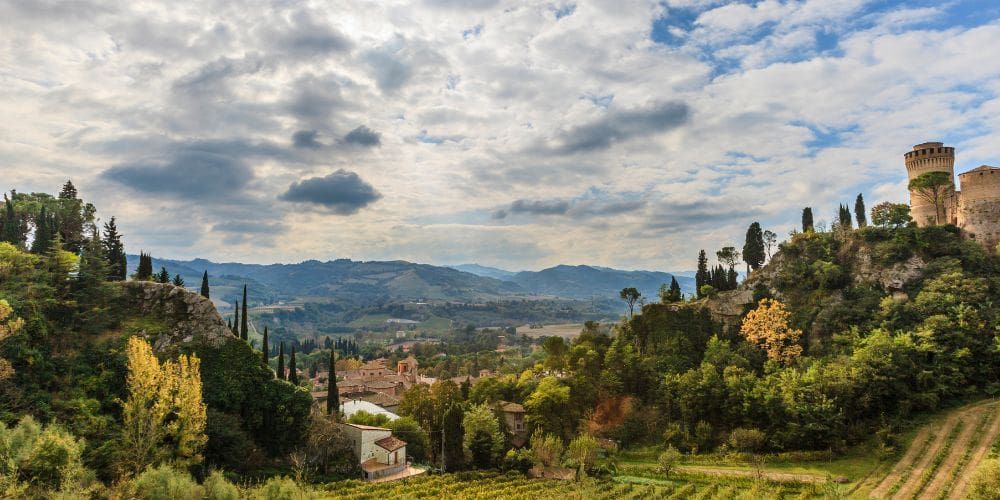
To admire the foliage in Emilia Romagna, Monte Penna is the best vantage point. Located above the Lama Forest (in the province of Forlì-Cesena) and most of the valleys, the top of the mountain is one of the most evocative spots in the entire Apennines. You can enjoy a view that stretches as far as the eye can see and be delighted by the centuries-old forests, which at the end of October come alive with a variety of colors recalling the great diversity and richness of the Casentino Forests. To complete this idyllic panorama, on clear days, you can see the Adriatic coast and the hills of Romagna.
To reach this unique destination, the Lama Forest, you have to work a little harder, as cars and motorcycles are not allowed, so you can only get there by mountain bike, following a long forest track, or on foot. At the edge of the mountain, in the middle of a beautiful and varied forest, there is a forest station surrounded by exotic plants of exceptional size, including a strange hawthorn tree that is about 300 years old.
To discover the Lama Forest, there is also a 16-seat shuttle bus, the Wild Bus, which runs from July to October. It also has an environmental guide who boards the bus and accompanies passengers on their discovery of these places and their secrets.
Best time: late October-November.
Where to park: the most convenient parking lot is Fangacci in the municipality of Campigna (FC).
Services: a shuttle bus is available to reach the park.
Hiking: yes, starting from Passo Fangacci, you can reach Monte Penna by crossing the Lama Forest on a circular route of about 16 km.
11. Clitunno Springs: here nature turns into Poetry and Wellness for the heart and soul
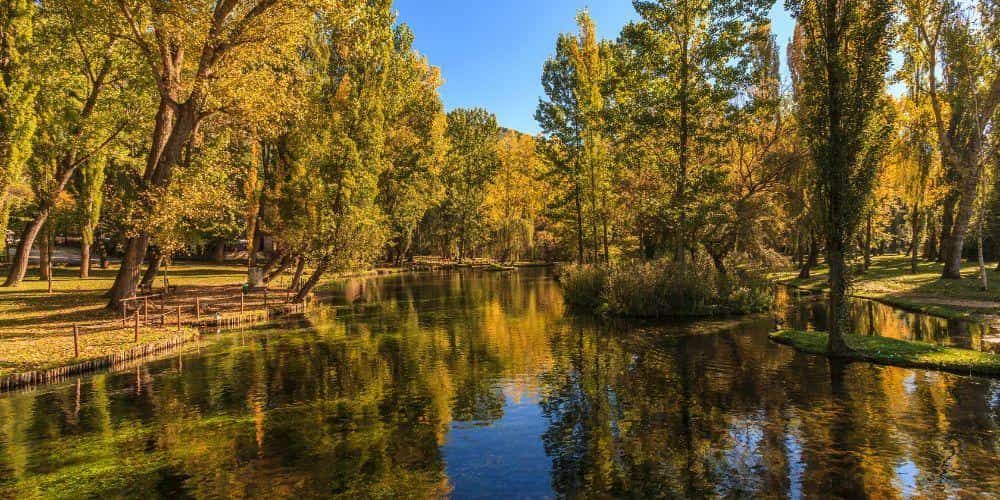
We suggest another place from which to admire the foliage in 2024. Clitunno Springs is a natural park that can be reached along the ancient Via Flaminia to reach the town of Campello sul Clitunno, in Umbria. Its waters are famous for the shades of its colors that ranging from emerald green to turquoise, from yellow to blue, characterized by the presence of many animal species, such as ducks, swans and other aquatic animals.
The Clitunno Springs are perfectly inserted in a habitat made of small waterfalls, streams of water, well-marked paths and bridges. The environment is completed by a rich vegetation, made of cypress poplars, which often reflect in the waters the characteristic colors of the Foliage period in Italy, accentuating their beauty. It’s certainly a place that will stimulate the relaxation and well-being of the soul, as well as a coveted destination and a sacred place of the Ancient Romans.
Best time: late October-early November.
Where to park: free parking is available in front of the park restaurant.
Services: essential services such as accessible restrooms and cafeterias are available at the entrance. Eating food inside the park is not allowed.
Hiking: yes, the most popular route, because it is very easy, is the one along the Clitunno River from Borgo Trevi to Fonti del Clitunno, about 7 km long.
11. The Canfaito beechwood in the Marche
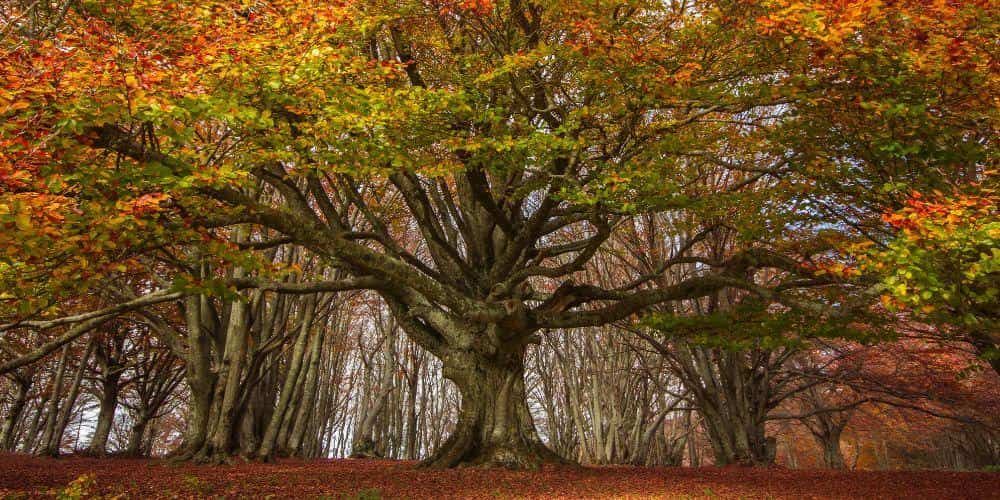
The Canfaito beechwood, in the Marche region, is one of the most beautiful places where to observe the foliage in Italy. It seems like an enchanted place, halfway between our dimension and a magical world. The beechwood is located on a plateau, in the province of Macerata, and is part of the Mount San Vicino and Mount Canfaito Regional Nature Reserve.
In Canfaito wood there's also the oldest beech of this region, included in the list of Italy's 300 monumental trees. From October to November this place is dyed with wonderful colors, a thousand shades of orange, red, copper, gold that mix with the ones of the sky in a blend of absolute wonder. With the fog, the beech wood becomes even more beautiful, because everything becomes almost surreal. Time seems to stop and the energy of the environment is overwhelming.
Best time: mid-October to early November.
Where to park: there is a dedicated parking lot in front of the entrance.
Services: public restrooms and barbecue areas.
Hiking: yes, you can choose between an easier and a more challenging route. The first is trail no. 6, about 4.5 km long, starting from Canfaito and ending at a rocky viewpoint overlooking the Matelica valley (MC). The second is the 7 km CAI 209 route, which connects the beech forest to the village of Elcito (MC), also passing through Prati di Roti and the Abbey of Valfucina.
19. Urban Foliage in Italy: admiring autumn in the city
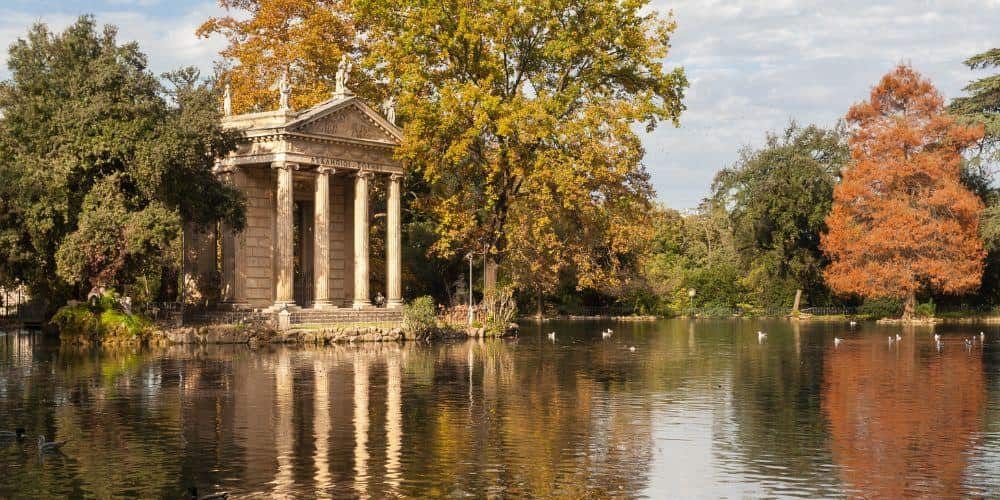
Like in Milan, Rome also offers splendid views for Urban Foliage. In the capital city, with nature turning yellow, red, orange, and brown, you can admire truly evocative scenery even just a few steps from home, in the city. In parks or green areas, along avenues or along large rivers. Of course, Villa Borghese is a must at this special time of year.
One of the largest parks in Europe, with its trees and avenues, it allows visitors to admire its beauty in all its glory, especially in the autumn months, with its vivid colors. Whether walking alone or with the family, by bicycle or on a rented rickshaw, Villa Borghese in autumn is an experience not to be missed for discovering the foliage in central Italy.
The inhabitants of the Eternal City know this well: to recover from the hectic pace of everyday life, a walk in this historic place offers moments of relaxation and peace, and with the warm colors of nature, the atmosphere becomes almost dreamlike.
Best time: September-November.
Where to park: the villa has numerous entrances, depending on which you can find various paid parking spaces (blue lines) in the surrounding area; there are also secure parking lots, also paid, in the vicinity, such as Parioli Parking, Pinciano Parking, and Saba Villa Borghese.
Services: inside the villa, there are cafes and public restrooms, as well as two cinemas, a theater, and areas dedicated to children, dogs, and runners. You can rent bicycles and rickshaws to get around. It is also possible to take a small train for a complete sightseeing tour.
Hiking: no.
Catch the chance to visit the Borghese Gallery8. The Enchanted Valley in Majella in Abruzzo
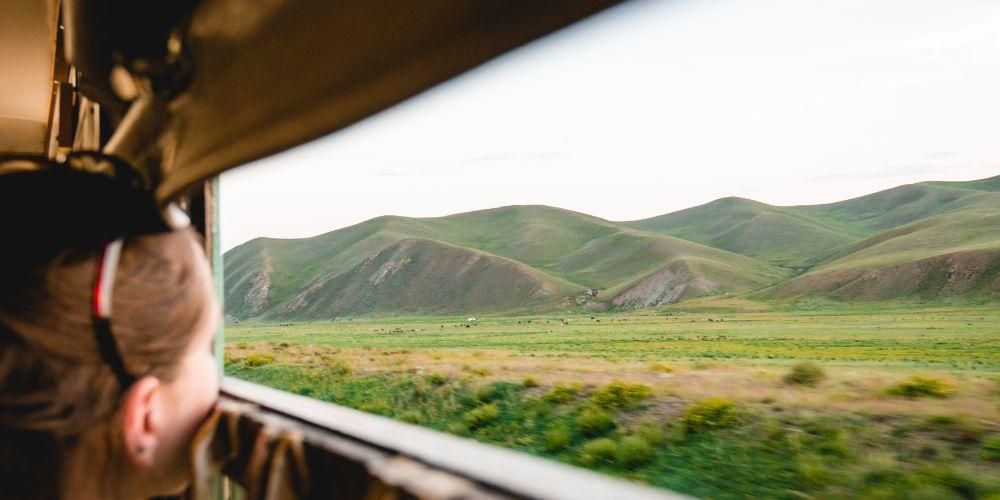
An unforgettable place to visit in Abruzzo at this time of year is undoubtedly the Orfento Valley, also known as “The Enchanted Valley” located in Caramanico Terme, in the province of Teramo. Between October and November, Mother Nature paints the poplars and maples with shades of yellow and red. The crystal-clear river flows impetuously between rocks and trees, and the breeze blows the leaves down like golden snowflakes. It is a pleasure to walk in the deep gorge, getting drunk on the intense smell of the forest and listening to the gurgling of the river.
It is a stage of a slow trip through the heart of the region, along plateaus, valleys, and small villages, where time seems to have stopped and nature is unspoiled. Following a winding route through mountains, gorges, and national parks, travelers enjoy a unique display.
You can experience all this by traveling on the Trans-Siberian Railway of Italy. This is a historic train that covers 128 km, the ancient route between Sulmona and Isernia, in Molise, passing through small towns and national parks. You can enjoy a breathtaking adventure, an alternative and evocative way to see the foliage in 2025!
Best time: October-November.
Where to park: there is free parking in Caramanico Terme and another car park near the Park Visitor Center at the start of the Sentiero delle Scalelle trail. For the Transiberiana, it is advisable to park in the free car park near Sulmona Central Station.
Services: Registration points for unguided access, guided excursions by reservation; possibility to attend environmental education workshops; rental of mountain backpacks for carrying children. There is an infopoint selling maps, books, and themed gadgets.
Hiking: yes, the most popular trails are the Scalelle and the Anello del Ponte del Vallone. The first crosses natural stone steps along the waterways and is about 4 km long, while the second is a circular route that starts and ends in Caramanico Terme, crossing the park for a total of 8 km.
7. Capracotta: The Garden of the Apennine Flora in Molise
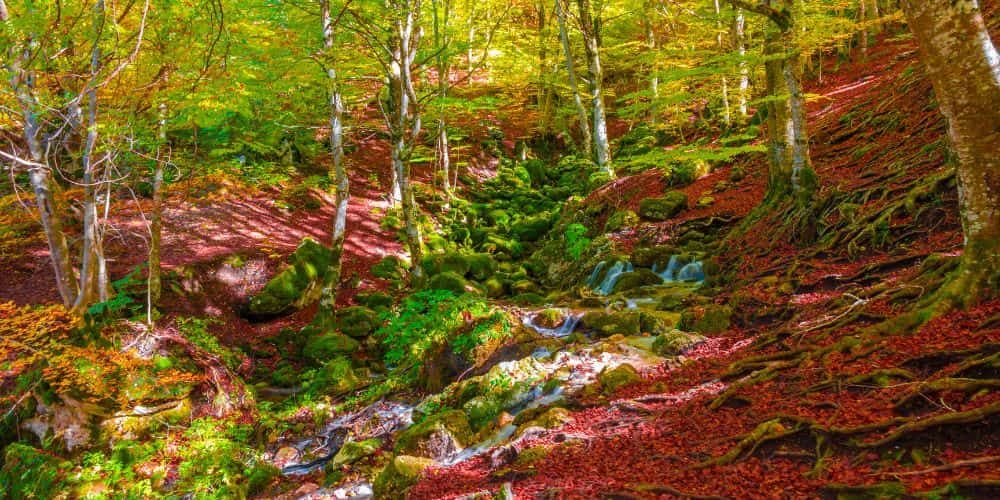
Although Molise is a small region, its landscapes are truly breathtaking. Have you ever heard of the Giardino della Flora Appenninica di Capracotta, one of the most beautiful centers in Upper Molise? It is one of the highest natural botanical gardens, at 1,525 meters, where you can admire the magic of southern Italian foliage. Here, the plant species of the native mountain and high mountain flora of the central-southern Apennines are preserved and protected.
Due to its morphology, it is home to numerous natural environments typical of the mountainous terrain, such as fir and beech forests, rock gardens, cliffs, marshes, and ponds. In addition, there are themed areas managed for educational purposes, such as terraces dedicated to medicinal plants and native horticultural varieties. These special themed areas, such as the Path of the Senses, the Pond, the Rock Garden, the Butterfly Corner, the Medicinal Plants, and the Walk among the Berries, offer visitors an extraordinary sensory experience. Unfortunately, pets are not allowed, with the exception of guide dogs.
Best time: September.
Where to park: The garden has its own free parking lot.
Services: Guided tours and educational trails for all ages are available.
Hiking: Yes, there are several trails in the Capracotta area. We recommend the medium-difficulty loop trail, which is 9 km long and passes through the Monte Campo ridge and the Prato Gentile mountain hut.
6. The Ferriere Valley of Amalfi in Campania
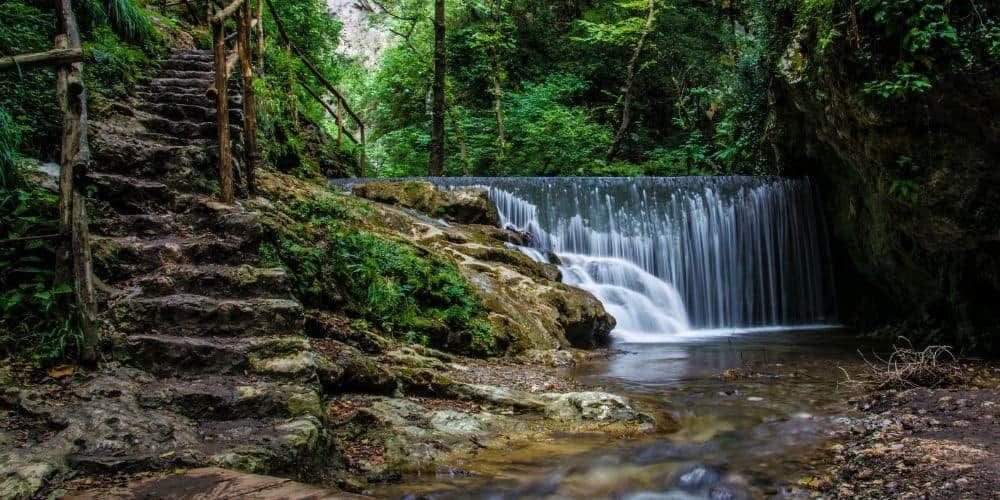
One of the most famous places in Campania is undoubtedly the Amalfi Coast, which is very crowded and popular for tourists in summer. But did you know that these places are also magical during the foliage season? Indeed, autumn is probably the best time to visit them, along with spring, due to the more pleasant climate and the decrease in tourist traffic.
If you are wondering where to see this spectacular event on the Amalfi Coast, we recommend visiting the Ferriere Valley Nature Reserve in the village of Pontone, in the municipality of Scala, a few kilometers from Amalfi. Here you will find typical Mediterranean scrub plants, covered in the warm hues of this season, but you can also admire rare plants, such as the carnivorous Pinguicola Hirtiflora and the giant fern Woodwardia Radicans. You can follow streams and be enchanted by picturesque waterfalls, which recreate a fairytale atmosphere.
Of course, a visit to the Ferriere Valley implies a peaceful trip to one of the villages on the coast.
Best time: September-October.
Where to park: Free or paid parking is available in the village of Pontone, or in Amalfi, in the Luna Rossa car park or the Porto car park, and then continue on foot.
Services: you can take part in hiking or cycling excursions and guided tours.
Hiking: yes, and we recommend the trail that starts in Ravello (SA), runs along the Rio Canneto canyon, crosses the reserve and reaches Amalfi, for a total of 8 km.
Book a tour at the Valle delle Ferriere Nature Reserve Waterfalls5. Costara Wood and the San Michele Tree in Basilicata
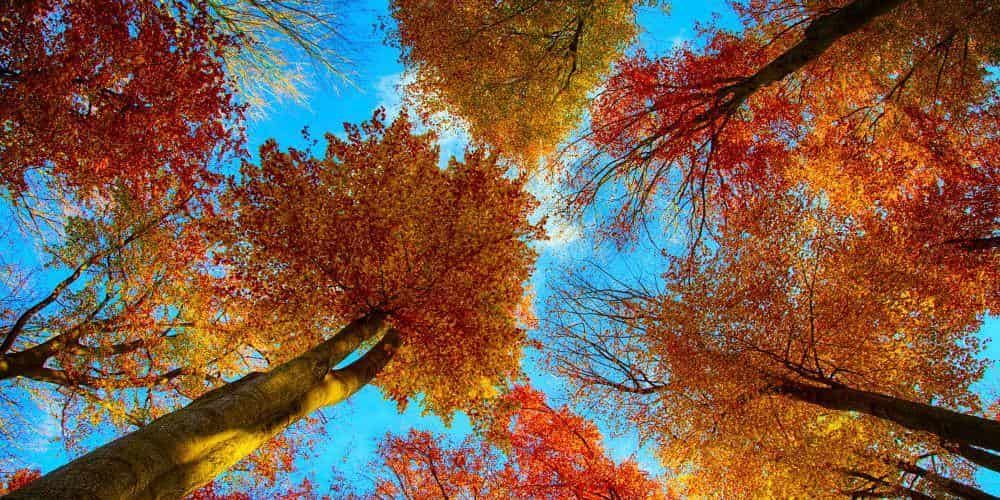
Another ideal place to admire the foliage in Italy is the Appennino Lucano Val d'Agri Lagonegrese National Park, in Sasso di Castalda, Basilicata. Nature is lush and in the nearby Costara Wood autumn comes in small steps, like a group of dancing colorful butterflies. Walking among the beech trees, mesmerized by the iridescent colors in the sunlight, it is easy to come across deer and fawns, and it feels like being in a fairy tale.
A shower of painted leaves covers the forest paths like a colorful carpet, preparing us for the sight of the San Michele tree. This is a monumental, centuries-old beech tree, a “father tree” of the region, which is between 300 and 400 years old: it is a privilege to be delighted by its ancient beauty.
Best time to visit: late October-early November.
Where to park: you can park in the space in front of the woods, near the refreshment area.
Services: the park has picnic areas and an adventure park for the more energetic.
Trekking: yes, there are several trails. The one from Lake Laudemio to Monte Papa, for example, is for experts and is about 13 km long. The trail to Monte Volturino (1,800 meters) is about 11 km long and starts from the Covone di Marsicovetere spring (PZ). Finally, the Madonna Nera di Viggiano trail is the longest, covering a total of 52 km in stages.
4. The Gargano Park Nature Reserve: the Umbra Forest in Apulia
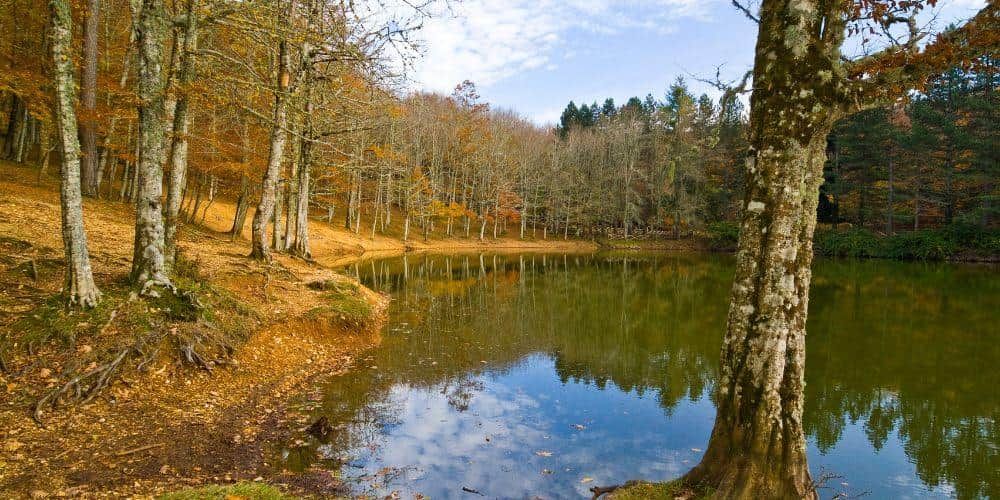
In the heart of the Nature Reserve in the Gargano Park, in Apulia, the Umbra Forest is a protected natural area, a nature reserve with over two thousand species of plants, considered a World Heritage Site. It is an ideal destination for those who enjoy walking and hiking amid the typical autumn colors of the trees and for lovers of foliage in Italy.
The name “Umbra” comes from the Latin “umbrus,” which translates as gloomy, shady, because the tops of its thick trees limit the passage of sunlight to the ground. During the fall season, the Apulian forest is dyed with yellow and red, offering viewers an unmissable spectacle. Among forests, hills, olive groves, oaks, maples, and centuries-old beech trees, you will find prehistoric remains, sea cliffs, and folk traditions.
Within the area, there are numerous itineraries to follow to admire the colors of the foliage in southern Italy: you can choose between the more challenging ones, suitable for experienced hikers, or the gentler ones, perfect for picnics, taking advantage of the many refreshment points and equipped picnic areas.
Best time: September-November.
Where to park: there are many secure car parks in the various towns surrounding the reserve, such as Vieste, Peschici, and Monte Sant'Angelo.
Services: you can book horse riding and off-road tours, as well as participate in caving and diving sessions.
Hiking: yes, we recommend the Sentiero dell'Amore (Path of Love), which connects the Bay of Mergoli/delle Zagare to the Bay of Vignanotica in about 3 km. Or the circular route that runs along Laghetto d'Umbra, in the Umbra Forest, which is about 7 km long.
3. The Sila Plateau and the Reserve of the Giants in Calabria
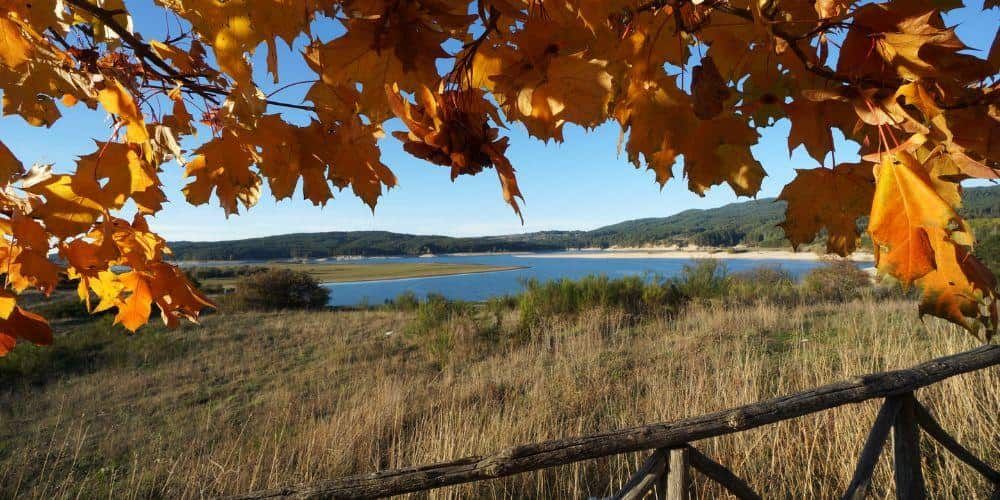
Autumn in Calabria is a magical season, gently leading us from the warm summer days to the cold winter days; during this transitional period, its colors become a caress for the soul.
One of the most representative places in Calabria in terms of foliage is undoubtedly the Sila Plateau, considered a must-see destination for lovers of autumn. Here, you can enjoy a unique spectacle, a real feast for the eyes, within the Reserve of the Giants of the Sila, the only FAI property in this region. A fantastic scenery unfolds before your eyes, thanks to the splendid larch pines. During autumn, you can stroll among the Giants, majestic 350-years-old larch pines, immersed in the typical colors of this season, in a fairytale atmosphere. Remember to bring your camera to capture the beauty of nature in this wonderful place.
Best time: October-November.
Where to park: there are no specific parking areas, but you can leave your car along the road leading to the reserve and continue on foot. Alternatively, you can get there by historic train from Camigliatello Silano.
Services: guided tours are available.
Hiking: yes. We recommend the circular route starting from the village of Croce di Magara, which crosses the reserve and covers a distance of just over 6 km.
2. The Tassita Wood on the Nebrodi Mountains in Sicily
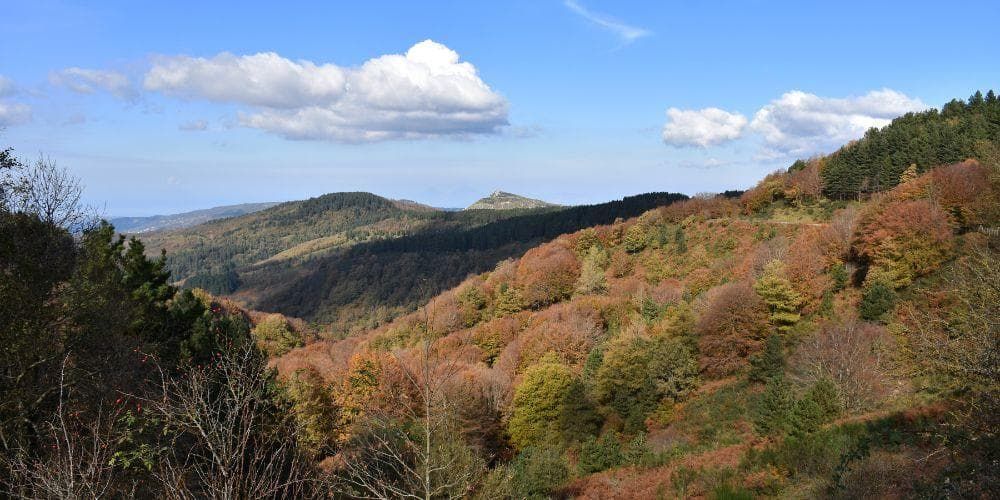
Another enchanting location to observe the foliage in 2025 is Sicily. Particularly from the Nebrodi Mountains, in the Sicilian Apennines, it is possible to admire the transformation of the trees as they change their appearance. In particular, in the Tassita Wood (the Yews Wood) a very popular place during this season, you can walk along countless paths among the centuries-old trees composing it: maples, beeches, holly trees, and, of course, yews, which give it its name. This tree is very resistant and is a real rarity in these places, as it usually grows in northern Europe; but above all, it is very poisonous, and its berries should never be touched.
This place, located in Caronia, in the province of Messina, is also known as the Fairy Forest because of its magical atmosphere, especially at sunset.
Other recommended places are the Ficuzza Wood and the Madonie Park in the province of Palermo, for pleasant walks in nature.
Best time: September-October.
Where to park: you can park at Portella dell'Obolo, a designated area located along the SP168 provincial road, and then continue on foot.
Services: guided tours are available; for the more energetic, there is an adventure park.
Hiking: yes, the trails are generally circular, starting from the Portella dell'Obolo pass, near Capizzi (Messina), and are about 6-7 km long.
1. Between the Trexenta and the Barbagia in Sardinia
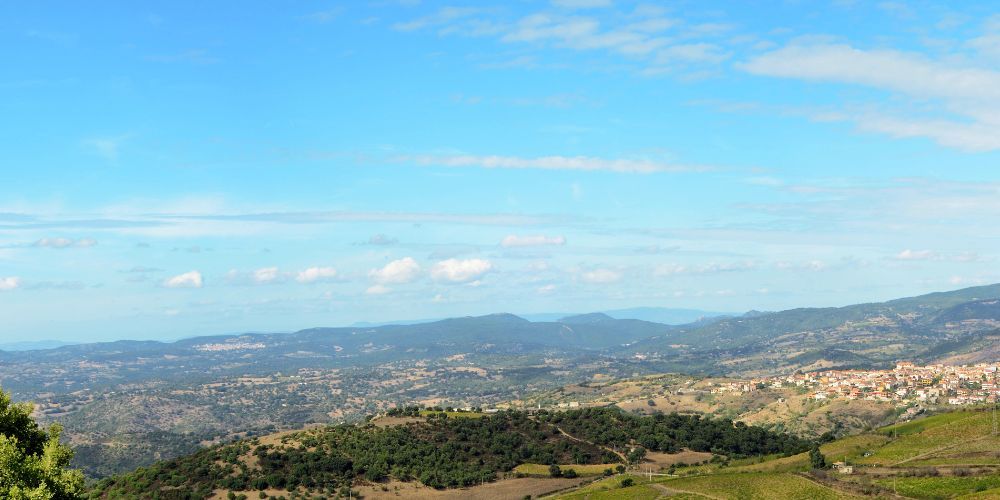
Don't miss the opportunity to visit these places during the magic of this season, which, from a naturalistic point of view, has no comparison with the coast, but rather has much to offer in terms of archaeology, folklore, and food and wine.
Best time: October-November.
Services: local products can be tasted along the route.
Hiking: no.
The best places of foliage in Italy in 2025
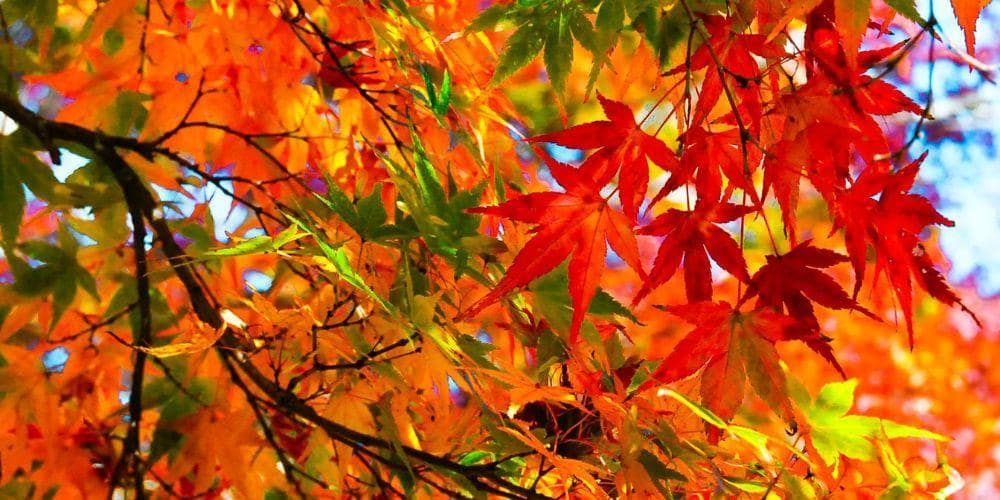
During the magical autumn months, Mother Nature treats the most romantic and melancholic among us to the magic of tree leaves, which change color from green to yellow, orange, red, and brown before falling, completely transforming the landscape. This is when this fascinating natural phenomenon known as foliage appears before our eyes.
The 20 places that we at Visit Italy recommend for experiencing foliage in Italy are:
• Val D'Ayas in Valle D'Aosta;
• The Langhe in Piedmont;
• Sempione Park in Milan, Lombardy;
• The Sella Art Park in Borgo Valsugana in Trentino Alto Adige;
• Zemola Valley in Friuli Venezia Giulia;
• Valley of the delle Sphynxes in Veneto;
• Aveto Park in Liguria;
• Casentinesi Forest Park in Tuscany;
• Lama Forest in Emilia Romagna;
• Clitunno Springs in Umbria;
• The Canfaito Beechwood in Marche;
• Villa Borghese in Rome, Lazio;
• The Orfento Valley in Abruzzo;
• Capracotta in Molise;
• The Ferriere Valley of Amalfi in Campania;
• The Costara Forest in Basilicata;
• The Gargano Park Nature Reserve in Puglia;
• The Reserve of the Giants in Calabria;
• The Tassita Forest in the Nebrodi Mountains in Sicily;
• Between Trexenta and Barbagia in Sardinia.
FAQ
Best regions to see the foliage in Italy?
Every region in Italy, from the North to the South, can offer stunning landscapes in Autumn. So, if you wish to enjoy the foliage in Italy you have just to choose a place along the Boot.
When is foliage time in Italy?
Foliage in Italy is a phenomenon that happens from the end of September to the end of November, therefore during Autumn months.
When is it foliage time in the italian Alps and the Dolomites?
The best time to see the foliage on the highest peaks of the Alps and Dolomites is generally from late September to mid-October. Lower-lying areas and valleys, on the other hand, remain covered in colorful leaves until mid-November.
Any Shooting tips?
In order to take perfect photos during the foliage season, you should choose the golden hour: lights are perfect at that time. But do not underestimate rainy or cloudy days, that give a unique atmosphere. The second tip is to carefully choose the equipment.
About the author
Written on 21/09/2024

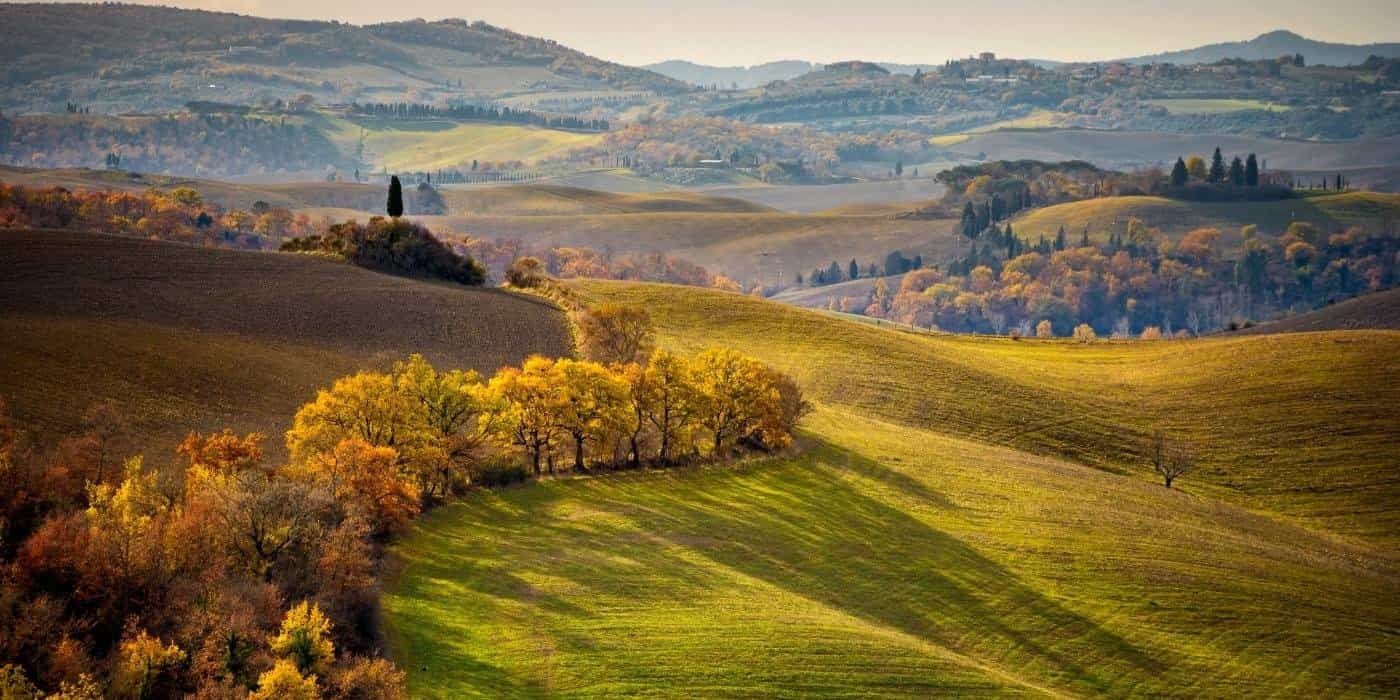

Simone Spolitu
Autumn is the most romantic season, thanks to its amazing colours. Here are the most attractive places to see the foliage in Italy in 2025